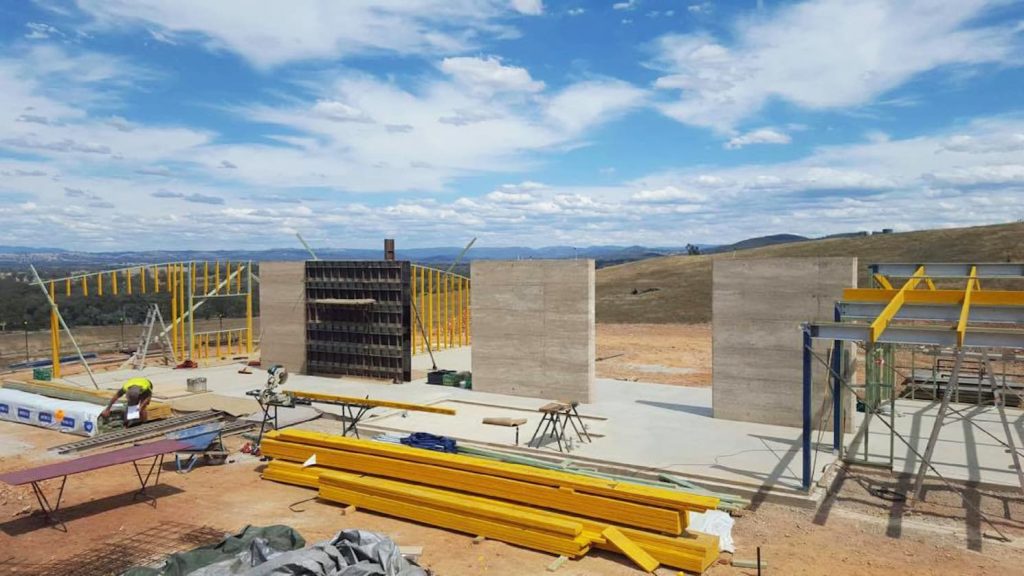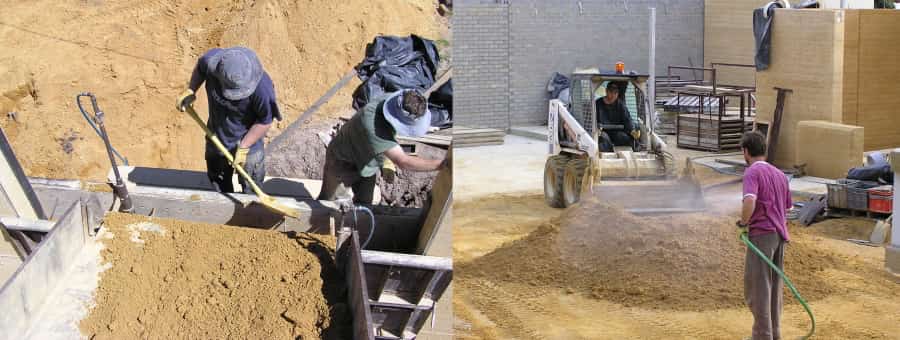How we build our rammed earth walls
People often ask us how rammed earth walls are actually constructed. While we have written about the technical properties of rammed earth walls in the main section of our website, this blogpost will detail the setup, mixing, compaction and strip down processes of constructing a rammed earth wall.
Rammed Earth Formwork
We use specialised rammed earth formwork constructed from steel and covered with a structural ply board which creates an ‘Off Form Finish’. Off form finishes mean the final finish of the wall is what you see when formwork is removed, a textured finish that is then sealed.
The formwork ranges in length from 600mm to 2400mm and in vertical heights of 300mm and 600mm. The design of the formwork allows them to be joined together to increase the length of the wall where required, depending on the plan.
It is important to understand that the type of soil used to construct your rammed earth walls will determine the length that can be built in each set up, but generally should not exceed 4500mm in length.

Setting up Rammed Earth Formwork
The first step in constructing rammed earth walls is marking exactly where the walls will be built on the concrete slab or footings.
At this stage consideration must be given to the overall aesthetics of the build and floor plan, as articulation joints are required in all masonry walls.
Articulation joints are vertical joins between wall panels which help to control lineal shrinkage of the material – to prevent cracking in the wall as it cures (dries) and to allow for concrete slab and footing movement without cracking the wall.
The first formwork lift is set up by placing a formwork panel on either side of the marked out area where the wall is to be built, inserting spacers to separate the two formwork panels at the required wall thickness, these are then bolted together.
End shutters are inserted at either end of the formwork panels to form the ends of the wall being built. The final stage in setting up is to level the end shutters so that the wall will be vertical (900) when built.
The above process is repeated for each section of wall being built.
Rammed Earth Construction
An earth/cement mixture is then combined with water to create the correct moisture level for rammed earth wall construction.
A quick guide to calculate whether the mixture is at the right moisture level is to squeeze it in your hand – if it holds together after this, then crumbles when dropped, it is ready to be compacted.

Once the moisture level is right, the earth mixture is hand shoveled into the formwork in 150mm deep increments and compacted down with pneumatic tampers. This process is repeated until the compacted earth is to the top of the formwork lift.
The formwork set up process is then repeated along with the compacting for every consecutive lift until the wall reaches its completed height.
To construct rammed earth over doors or windows, we utilise engineered T-Bar lintels, which are placed over the opening during ramming to support the earth above the opening.
When recesses are required in walls, formers are placed into the formwork set up and soil is placed and compacted around them to produce the required opening or shape in the wall.
In the top 600mm of the wall metal rods are inserted during compacting to provide a tie-down system for a timber top plate, this is for securing the roofing structure.
Electrical conduits and wall boxes are rammed into the wall at points where power points and light switches are required.
Conduits are also placed into the wall to allow water plumbing pipes to be inserted where required. Where an area is to be tiled over or hidden by joinery, plumbing pipes can be chased (cut) into the wall.
The completed wall is left in form overnight whilst initial curing takes place.
Removal of Formwork
The formwork is then removed ‘stripped-down’ the following day and any formers placed in the wall during construction are removed.
The newly stripped wall is then detailed to repair minor imperfections, removing any earth that has protruded through bolt holes in the formwork, as well as plugging holes where bolts where inserted through formwork.
As mentioned above the wall surface is an Off Form Finish, exhibiting the natural beauty and character that is unique to a rammed earth wall.
The rammed earth construction process is the same for new homes and renovations, to see our rammed earth walls in complete homes, view our gallery.
